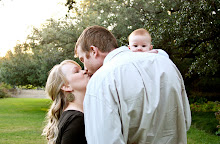This method has worked as a form of birth control for us for several years and for pregnancy achievement when we desired. Once you get the hang of charting, it becomes very easy! You get to know your body very well. And, in some cases, you can determine when "things just aren't quite right" with your body and you can seek further care.
Refer to the charts below:
1. Chart the cycle you are on (in this case, she is on #11), your age, the length of the cycle (first day of period to first day of the next), and the date your cycle started.
2. Then, chart the cycle day starting with "1" as the first day you see blood. The "date" is the day of the month, the day of the week.
3. Each day you will take your waking temperature at the same time each morning. Your temperature will be low until after you ovulate. The day after your most fertile day of ovulation (peak day), your temperature will rise and you are safe for intercourse without protection. It will drop again when you begin your period. If it does not lower again on the day you expect your period, and you have 18 days of high temperatures in a row after ovulation, you can expect to see a positive pregnancy test!
4. Check the days you have intercourse and be sure that you are especially noting your most fertile time which is shown below in this example highlighted in yellow. You will need to abstain or use a protective barrier method, such a condoms, when having intercourse on your fertile days if you are not wanting to become pregnant. If you do want to become pregnant, you will want to chart your fertile days carefully and plan intercourse on those days.
5. Your cervical fluids are the indication of fertility. If you are not on your period, you will be dry, creamy, sticky, or have fertile egg white cervical fluids. Click here for a website that has a great representation of the cervix and fluids.
6. Notes can be taken on travel, moods, stress, PMS, illness, exercise, etc....
Chart #1: This women did not want to become pregnant on this cycle
and did not. She started her period again after her 28 day cycle.
and did not. She started her period again after her 28 day cycle.

Chart #2: This women wanted to become pregnant on this cycle
and did. Her temperature remained high after her 28 day cycle.
and did. Her temperature remained high after her 28 day cycle.
 These charts are only examples and this is a very simplified review of charting. If you have questions or are interested in using this method, I encourage you to read up on it and ask questions on how it can be used by you.
These charts are only examples and this is a very simplified review of charting. If you have questions or are interested in using this method, I encourage you to read up on it and ask questions on how it can be used by you.





1 comment:
Just dropping by to thank you again for being a wonderful referral for the many moms that visit my site.
Post a Comment